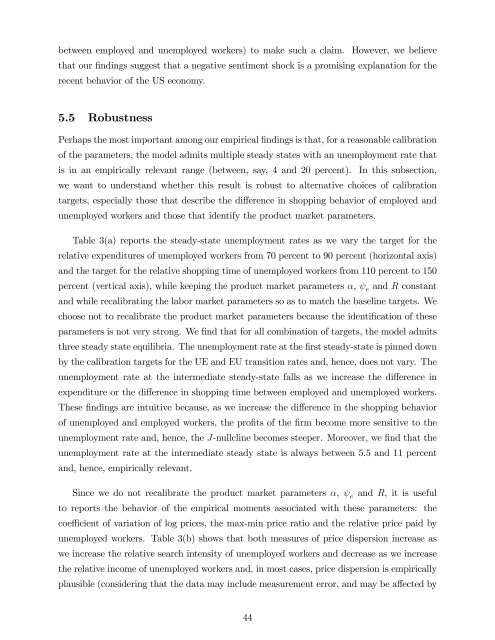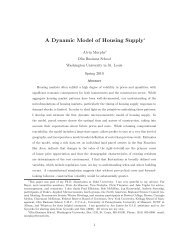Shopping Externalities and Self Fulfilling Unemployment Fluctuations*
Shopping Externalities and Self Fulfilling Unemployment Fluctuations*
Shopping Externalities and Self Fulfilling Unemployment Fluctuations*
You also want an ePaper? Increase the reach of your titles
YUMPU automatically turns print PDFs into web optimized ePapers that Google loves.
etween employed <strong>and</strong> unemployed workers) to make such a claim. However, we believethat our …ndings suggest that a negative sentiment shock is a promising explanation for therecent behavior of the US economy.5.5 RobustnessPerhaps the most important among our empirical …ndings is that, for a reasonable calibrationof the parameters, the model admits multiple steady states with an unemployment rate thatis in an empirically relevant range (between, say, 4 <strong>and</strong> 20 percent). In this subsection,we want to underst<strong>and</strong> whether this result is robust to alternative choices of calibrationtargets, especially those that describe the di¤erence in shopping behavior of employed <strong>and</strong>unemployed workers <strong>and</strong> those that identify the product market parameters.Table 3(a) reports the steady-state unemployment rates as we vary the target for therelative expenditures of unemployed workers from 70 percent to 90 percent (horizontal axis)<strong>and</strong> the target for the relative shopping time of unemployed workers from 110 percent to 150percent (vertical axis), while keeping the product market parameters , e <strong>and</strong> R constant<strong>and</strong> while recalibrating the labor market parameters so as to match the baseline targets. Wechoose not to recalibrate the product market parameters because the identi…cation of theseparameters is not very strong. We …nd that for all combination of targets, the model admitsthree steady state equilibria. The unemployment rate at the …rst steady-state is pinned downby the calibration targets for the UE <strong>and</strong> EU transition rates <strong>and</strong>, hence, does not vary. Theunemployment rate at the intermediate steady-state falls as we increase the di¤erence inexpenditure or the di¤erence in shopping time between employed <strong>and</strong> unemployed workers.These …ndings are intuitive because, as we increase the di¤erence in the shopping behaviorof unemployed <strong>and</strong> employed workers, the pro…ts of the …rm become more sensitive to theunemployment rate <strong>and</strong>, hence, the J-nullcline becomes steeper. Moreover, we …nd that theunemployment rate at the intermediate steady state is always between 5.5 <strong>and</strong> 11 percent<strong>and</strong>, hence, empirically relevant.Since we do not recalibrate the product market parameters , e <strong>and</strong> R, it is usefulto reports the behavior of the empirical moments associated with these parameters: thecoe¢ cient of variation of log prices, the max-min price ratio <strong>and</strong> the relative price paid byunemployed workers. Table 3(b) shows that both measures of price dispersion increase aswe increase the relative search intensity of unemployed workers <strong>and</strong> decrease as we increasethe relative income of unemployed workers <strong>and</strong>, in most cases, price dispersion is empiricallyplausible (considering that the data may include measurement error, <strong>and</strong> may be a¤ected by44
















